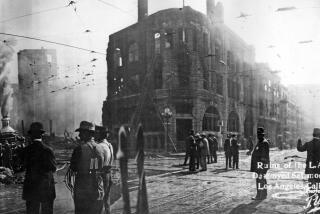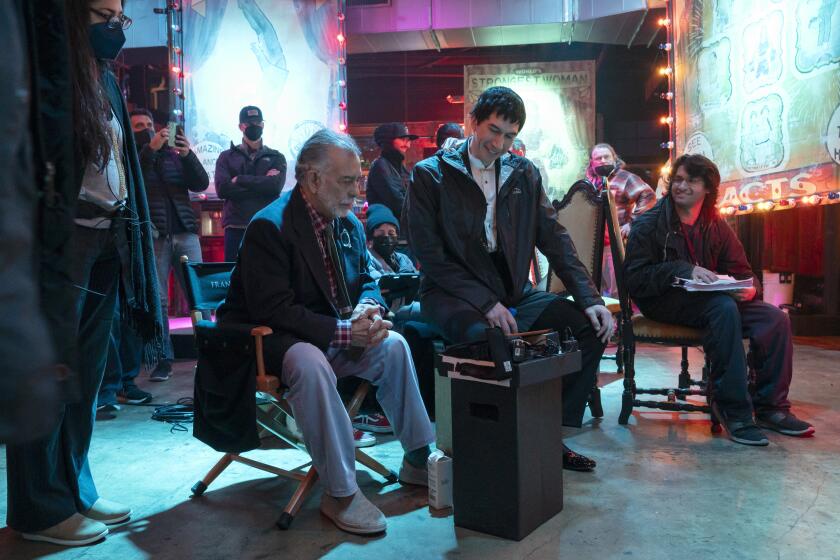From the Archives: 100 years ago, Charlie Chaplin began work in his new studio
One in a series remembering the Los Angeles Times’ 100-plus years of covering Hollywood.
One hundred years ago this week, The Times’ Grace Kingsley and cartoonist Gale (Edmund Waller “Ted” Gale) visited Charlie Chaplin’s new film studio on La Brea Avenue. Chaplin had recently agreed to a million-dollar contract to make eight two-reel comedies.
Chaplin utilized the facility through the making of “Limelight” in 1952. It was later used for television production, served as the home of A&M Records and since 2000, has been headquarters for the Jim Henson Company. It can be seen in the 2011 movie “The Muppets” and was declared a Los Angeles Historical-Cultural Monument in February 1969.
Kingsley served as The Times motion picture editor from 1914 until her retirement in 1933. She continued to write movie reviews and features part-time until she was 80. Gale’s drawings were featured in the pages of The Times from 1907 until 1934, when he moved to the Examiner over editorial policies.
Here are Kingsley’s observations and Gale’s illustrations, originally published Jan. 20, 1918.
-------------
Locking his new million-dollar contract in the safe of his new half-million dollar studio, Charlie Chaplin, the world’s most famous film comedian took his dinner pail and clanked the ball and chain of labor again last week, after his four months’ vacation.
“And we knew Charlie when he owned only only one picture!” exclaimed Gale, the artist, as we drove around the corner that brought us suddenly, amidst the pampas plumes and tiny orchards of Hollywood, plump into the little bit of quaint old English street, which is really, once you’re inside the buildings, the new Chaplin studio, where he began work last Tuesday on his first picture for the First National Exhibitors’ Circuit.
The camouflage is very deceptive. Inside the building, which looks like a church, for instance, there is a mean old commercial time clock, like a conscience, where the workmen ring in and where dwell — shades of St. John the Scribe — the Chaplin Boswells, the publicity department. Also, just as you fancy there will step from one of the half-timbered Elizabethan doors a clanking knight of old, instead there emerges an overalled Pete Props. “Say,” he says, “whada you think the boss wants now? A crowd o’ tarantulas? I ain’t no tarantula hound. And I don’t know no tarantulas! Can you beat it!”
Inside the office as you enter, there is quite a little host of people. It is the army that holds the sector of approach to Charlie’s private office and and the stages. There you go over the top — if you can. Because, of course, everybody in the world wants to see Charlie in his new professional home, and some folks are very ingenious about getting their way too. For instance, here’s the way one woman got in the other day. She had found a card outside which the comedian had given somebody in order to insure admission, and which Charlie had dropped when his guest left. And the woman had wanted to sell Charlie a patent health regimen of some sort! Just as if Charlie weren’t as athletic as a prize fighter, and as if he didn’t, just for exercise and fun, climb all over the skyscraping girders of the news stages.
He gave us several dollars worth of time the other day. Not that he ever lets you feel he’s doing you a favor. Charlie will never be an upstage mortal. On the other hand, there is something boyishly appealing about him, so that when he tells you in perplexed confidence and a characteristic quizzical wrinkling of his face, “Oh my, but a fellow worries over his work,” you immediately feel as if you wish you could do it for him — as if he were a schoolboy with hard sums to do, and you would like to do them all for him.
So far as the studio is concerned, Charlie is like a kid with a new toy.
“Say, the fellow that couldn’t be happy here would be the fellow that would write a want ad in heaven.”
He leads you hospitably all over the place, making amusing little comments.
“I think I could like this place if I didn’t work here … See, here’s a lemon orchard back of the stage. Think lemons must be my lucky fruit — can’t escape ‘em — had a lemon orchard back of us at Essenay and one at the Lone Star — hope they keep the lemons in the orchard, though … No, I’m not going to live in the studio — Brother Sid and Mrs. Sid are going to try it, but none of the put-out-the-dog-and-let-in-the-cat-and-lock-the-cellar-door-stuff for me at my workshop … But, see I’ve got a beautiful apartment” — it’s a large corner room, where there are bay windows and odd little dormer windows — “this is to be a combination office and reception-room, and there’s a door I can dodge out of and climb a tree in the lemon orchard if I want to get away from anybody … Yes, there’s a nice big swimming pool and there’s a tennis court, both to be used for business and pleasure.”
For the comfort of the fans, let us announce right here, Charlie Chaplin wears his “salary” — which is what he calls his funny old clothes — right into his nice new studio. Only he has had his patched old shoes resoled.
But his pictures henceforth, according to present plans, will contain more of character study and more story.
“And how will the public like that?” inquires Charlie anxiously with his puzzled, quizzical little frown.
“What’s your first story?” we ask.
“All about a dog!” grins Charlie pointing to a scrap of a mongrel that has crawled to his feet and is licking his hands. That dog, by the way, was doomed to the pound, but they never got him. Charlie coaxed him into the studio, and while to Bingo, Charlie is a merely a little man with funny feet and magical stores of bread in his pockets, to Charlie he looks like a very good dog actor. So that’s all we found out about the picture, except that it has an employment bureau in it.
Just here in trooped a motley bunch of actors, and Charlie went to work.
“And now,” said Chaplin after an hour’s hard rehearsal of the gang, “and now I think a little rehearsal will do us good.”
That’s characteristic of the patience and hard work of the comedian, who really leads a double life — that of both actor and director. For Charlie Chaplin, the comedian with the midas touch of comedy which has the power to turn the meanest “prop” into golden laughter, works like a whirlwind and and notes every detail of both make-up and action on the part of his actors, and goes through every smallest part himself to show them. Why, he even dresses them sometimes when they don’t get on their make-ups to suit him.
The only prop in this scene, which was held in an employment agency, was a box filled with sawdust, the purpose of which was obvious. But Charlie didn’t let the frayed-out-old-actory person use it for that. “Just flick your cigarette ashes in it — so,” he prompted, and then he went through the part in a manner that showed him the artist he is, for the part was only a bit, yet you smile and you laughed and cried at the same time as he did it.
“This isn’t a rehearse — this is the original hearse,” exclaimed one of the actors as he stepped out of the strenuous scene, mopping his brow.
Charlie’s comedy seems entirely spontaneous — that’s its wonderful charm. But beneath it all he has the mathematics of merriment, the logarithms of laughter, at his fingers’ ends.
SIGN UP for the free Classic Hollywood newsletter »
How they are written
Charlie Chaplin is just Tom Sawyer when it comes to “writing” his stories.
In other words, he and his three principal staff men act out the stories as they go along, just as Tom Sawyer and Huck Finn “pretended” being pirates and robbers. These staff men are Charles Lapworth, well-known English journalist; Melvin Brown, writer and ex-tragedian, and “Chuck” Reisner, writer of popular songs, including the famous “Good-by Broadway, Hello France.”
The “writing” of the story is done in Charlie’s room at the Athletic Club, for obvious reasons, which will appear when it is related that the other night a bellboy, entering Charlie’s room, found the whole crowd rehearsing a wild scene and started to call for the police.
From which it will at once appear that in order to “write” comedy for Charlie it is well to be a prizefighter also. In fact, writing songs isn’t all that Chuck Reisner can do, he can knock out a man scientifically with his left as he writes a song with his right.
Melvin Brown is Chaplin’s high-test laugher. If Brown laughs at a “gag,” which is jazz English for a bit of comedy business, then Charlie is sure the worst gloomer in the audience will be likely to laugh, too. Not that Brown is a gloomer — he’s a very handsome and cheerful young man — but he’s been in this business a long while, and he knows the joke that first made Adam grin.
It is said that even now, Charlie has a new play in preparation — all about a spy, in fact, a burlesque on spy plays — that’s the funniest thing in captivity.
And yet, on his library table are to be found all sorts of high-brow books — thumbed and worn.
“For tragedy relief, I guess,” remarked Gale.
---
Movie Trailers
More to Read
Only good movies
Get the Indie Focus newsletter, Mark Olsen's weekly guide to the world of cinema.
You may occasionally receive promotional content from the Los Angeles Times.










